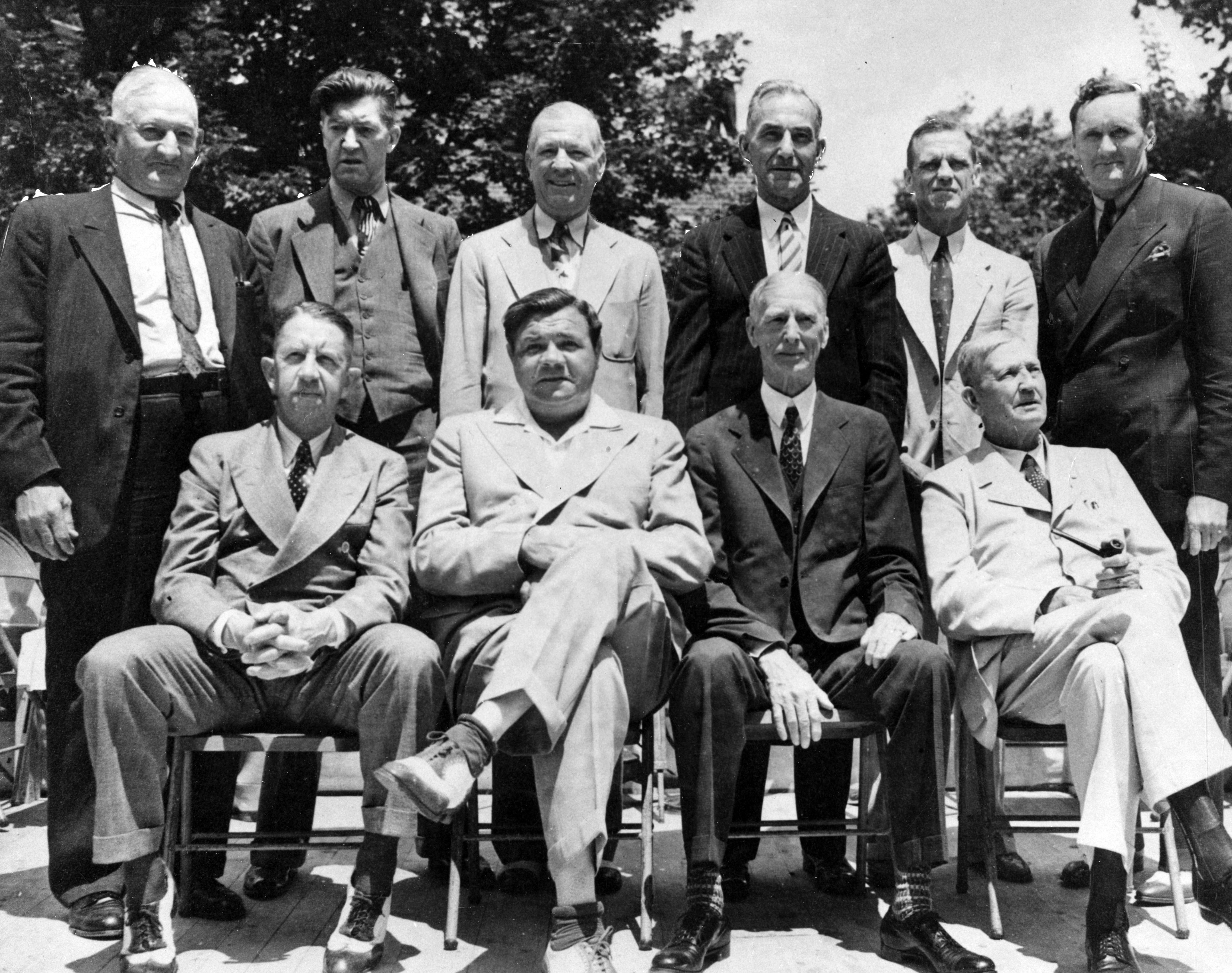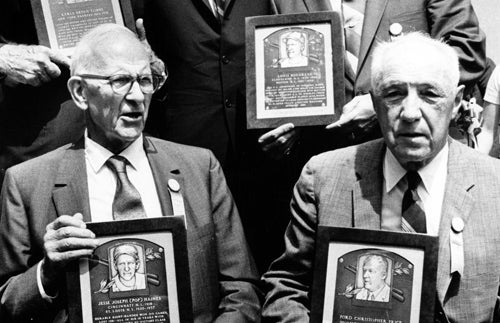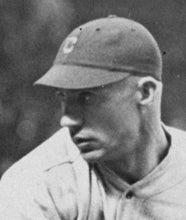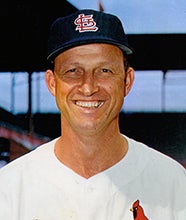- Home
- Our Stories
- 1960 - 1969
1960 - 1969
The BBWAA did not elect any candidates in 1960 and no BBWAA election was held the following year, but in 1962 two first-year candidates – Bob Feller and Jackie Robinson – were elected by the BBWAA. Robinson requested that only his on-the-field accomplishments to taken into consideration by the voters, and his original Hall of Fame plaque did not feature any description of his breaking the color barrier in 1947. Robinson’s plaque was re-cast in 2008 to reflect his role as an African-American pioneer in baseball. Ted Williams and Casey Stengel were featured in the star-studded Class of 1966 (the year the BBWAA decided to resume annual elections), and BBWAA candidates Roy Campanella and Stan Musial were elected in 1969. A screening committee was implemented in 1968 to limit BBWAA ballots to 40 players.
1960
No players received the required 75% of BBWAA ballots for election to the Hall. The top vote getter was future electee Edd Roush, who was named by 54.3% of the writers. Because the Veterans Committee held no vote, there was no induction ceremony in Cooperstown.
1961
1961 Induction Class
The only two players enshrined on July 24, 1961 were Veterans Committee selections Max Carey and Billy Hamilton, who was inducted posthumously and represented by his three daughters.
Hall of Famers in Attendance
Frank Baker, Max Carey, Joe Cronin, Joe McCarthy, Ray Schalk, Bill Terry
1962
1962 Induction Class
First ballot Hall of Famers Jackie Robinson and Bob Feller were enshrined along with Veterans Committee selections Edd Roush and Bill McKechnie on July 23, 1962. The Hall of Fame’s membership reached 90 in a 38 minute ceremony before of an audience of more 10,000 fans.
Hall of Famers in Attendance
Joe Cronin, Bob Feller, Joe McCarthy, Bill McKechnie, Jackie Robinson, Edd Roush
1963
1963 Induction Class
The Hall of Fame’s membership increased by four to 94, as John Clarkson, Elmer Flick, Sam Rice and Eppa Rixey were elected by the Veterans Committee. At this point in time, the BBWAA only voted every other year and did not vote in 1963. Rice and Flick were on hand to receive their plaques on August 4, 1963, while Clarkson and Rixey were posthumously inducted. Rixey died just five months before the ceremony, in February 1963. In contrast to today’s two to three hour ceremonies, it took just 35 minutes for these four men to be inducted. The first J.G. Taylor Spink Award for meritorious contributions to baseball writing was presented to its namesake, the driving force behind The Sporting News since 1914.
Hall of Famers in Attendance
Joe Cronin, Dizzy Dean, Bill Dickey, Elmer Flick, Jimmie Foxx, Frankie Frisch, Charlie Gehringer, Lefty Grove, Ted Lyons, Joe McCarthy, Bill McKechnie, Sam Rice, George Sisler
1964
1964 Induction Class
Seven new members were enshrined on July 27, 1964 at the 25th anniversary of the Hall of Fame. A special election of the BBWAA resulted in the induction of Luke Appling, Red Faber, Heinie Manush and Burleigh Grimes, while the Veterans Committee elected Miller Huggins, Tim Keefe and John Ward. All three Veterans Committee selections were inducted posthumously. Ring Lardner, a writer for The Sporting News and later known for his “You Know Me Al” column in the Saturday Evening Post, received the second ever J.G. Taylor Spink Award for meritorious contributions to baseball writing.
Hall of Famers in Attendance
Luke Appling, Joe Cronin, Red Faber, Elmer Flick, Frankie Frisch, Charlie Gehringer, Burleigh Grimes, Heinie Manush, Joe McCarthy, Bill McKechnie, Sam Rice, Ray Schalk, George Sisler, Bill Terry
1965
1965 Induction Class
Veterans Committee selection Pud Galvin was the lone inductee on July 26, 1965 in front of 22 of the 30 living Hall of Famers. Galvin, who became the 102nd member of the Hall of Fame, was inducted posthumously and his son Walter accepted the honor his father’s behalf. Hugh Fullerton, who died in 1945, was honored with the third J.G. Taylor Spink Award for meritorious contributions to baseball writing. Fullerton wrote for papers in Chicago, New York, Columbus and Philadelphia and was instrumental in bringing out the story of the 1919 “Black Sox” scandal.
Hall of Famers in Attendance
Luke Appling, Max Carey, Joe Cronin, Dizzy Dean, Bill Dickey, Bob Feller, Jimmie Foxx, Frankie Frisch, Charlie Gehringer, Hank Greenberg, Burleigh Grimes, Lefty Grove, Gabby Hartnett, Carl Hubbell, Ted Lyons, Heinie Manush, Bill McKechnie, Sam Rice, Edd Roush, Bill Terry, Paul Waner, Zack Wheat
1966
1966 Induction Class
Ted Williams and Casey Stengel were enshrined in front of 7,000 fans on July 25, 1966. Williams was the lone BBWAA inductee and received a then-record 93.4 percent of the votes, while Stengel was elected by the Veterans Committee. Stengel stole the show with his induction speech, which lasted a full 20 minutes longer than Williams’. Charles Dryden received the J.G. Taylor Spink Award for meritorious contributions to baseball writing. Dryden worked for newspapers in San Francisco, Chicago, Philadelphia and New York and coined the famous phrase “Washington – first in war, first in peace and last in the American League.”
Hall of Famers in Attendance
Joe Cronin, Bill Dickey, Joe McCarthy, Casey Stengel, Bill Terry, Ted Williams
1967
1967 Induction Class
The late Branch Rickey, Lloyd Waner and Red Ruffing were enshrined on July 23, 1967 in the last Hall of Fame induction ceremony to take place on the front steps of the museum. A brief rain shower interrupted the ceremony, in which Ruffing was inducted as the result of a runoff of BBWAA writers after they failed to induct someone the first time around. Grantland Rice covered baseball for numerous papers in the southern part of the country before moving to New York and received the J.G. Taylor Spink Award for meritorious contributions to baseball writing.
Hall of Famers in Attendance
Joe Cronin, Charlie Gehringer, Lefty Grove, Jackie Robinson, Red Ruffing, Ray Schalk, Bill Terry, Lloyd Waner
1968
1968 Induction Class
The Hall of Fame induction ceremony moved from the front steps on Main Street, to the steps of the newly-constructed Hall of Fame Library for the first time on July 22, 1968. Joe Medwick, the lone BBWAA inductee, was enshrined with Veterans Committee selections Kiki Cuyler and Goose Goslin, who choked up and had to cut his speech short. Damon Runyan, who covered the New York Giants for the New York American from 1911-1920 received the J.G. Taylor Spink Award for meritorious contributions to baseball writing.
Hall of Famers in Attendance
Max Carey, Joe Cronin, Frankie Frisch, Charlie Gehringer, Goose Goslin, Lefty Grove, Heinie Manush, Joe Medwick, Sam Rice, Edd Roush, Red Ruffing, Ray Schalk, Casey Stengel, Pie Traynor, Lloyd Waner, Zack Wheat
1969
1969 Induction Class
The Hall of Fame’s membership grew to 114 on a gray, wet day in Cooperstown on July 28, 1969. Roy Campanella, Stan Musial, Waite Hoyt and Stan Coveleski were enshrined in front of several thousand fans and a number of current Hall of Famers including Casey Stengel, Lefty Grove and Pie Traynor. The BBWAA voted in Campanella and Musial, while the Veterans Committee selected Hoyt and Coveleski. The J.G. Taylor Spink Award for meritorious contributions to baseball writing went to Harry Salsinger who wrote for Detroit News for over 50 years.
Hall of Famers in Attendance
Luke Appling, Roy Campanella, Max Carey, Stan Coveleski, Joe Cronin, Bob Feller, Charlie Gehringer, Lefty Grove, Waite Hoyt, Ted Lyons, Heinie Manush, Joe Medwick, Stan Musial, Sam Rice, Edd Roush, Ray Schalk, Casey Stengel, Bill Terry, Lloyd Waner, Zack Wheat







